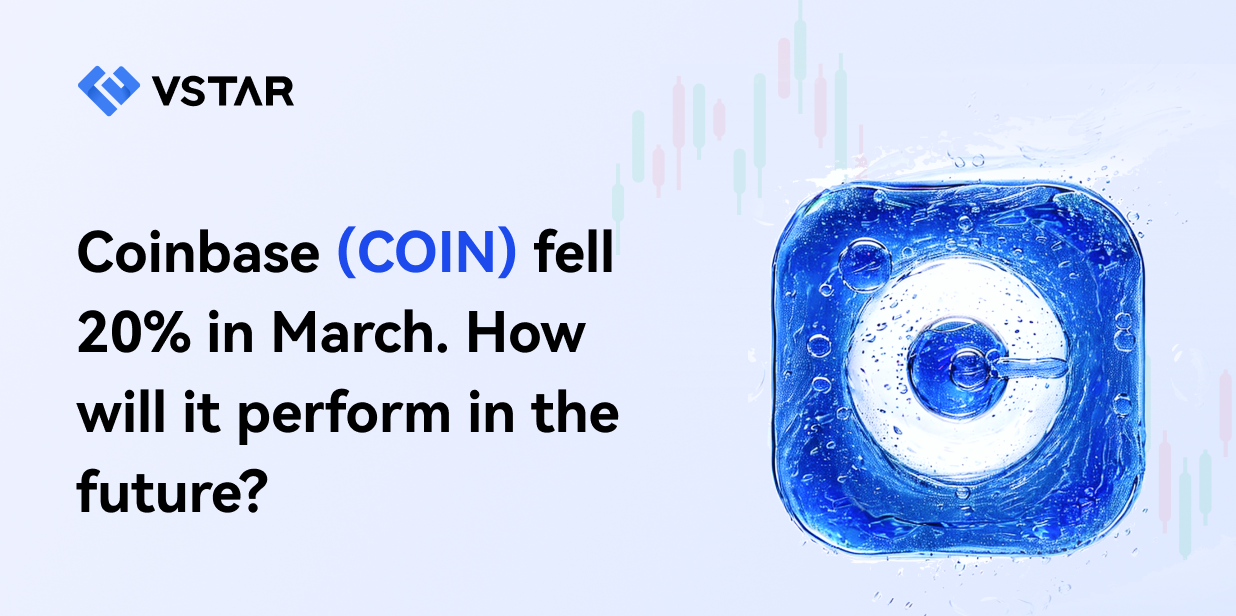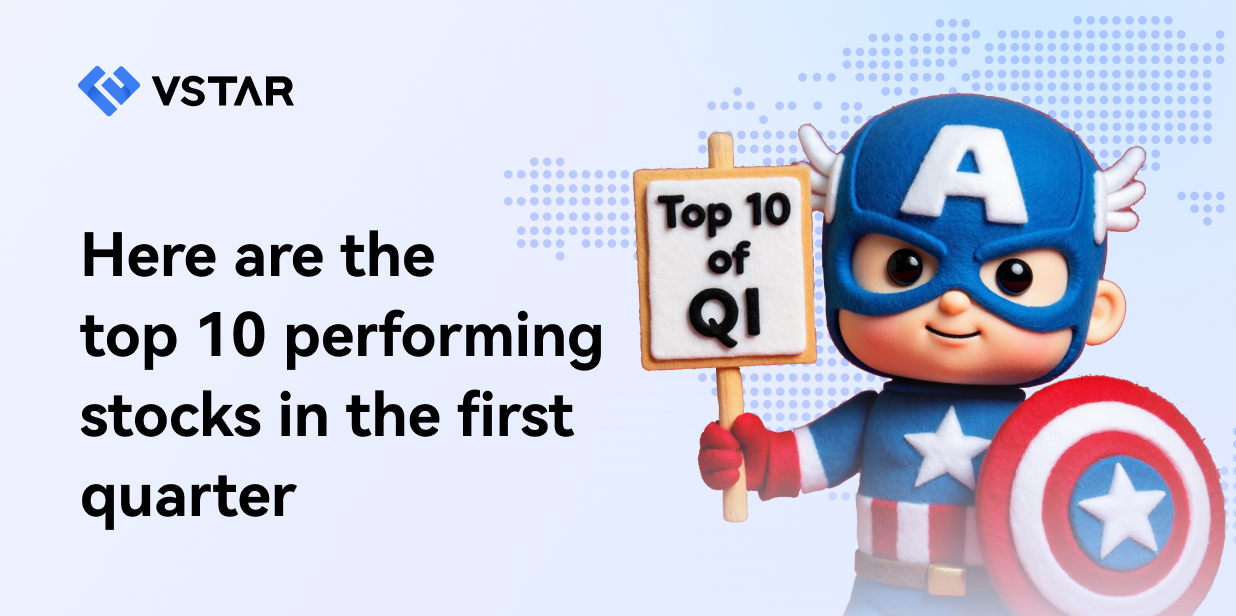- Nvidia's Blackwell architecture signifies a leap in AI computing, boasting substantial performance improvements over its predecessor, Hopper, with 2.5x and 5x increases in FP8 training and FP4 inference, respectively.
- Fifth-generation NVLink interconnect offers double the speed, facilitating seamless communication among up to 576 GPUs, crucial for scaling AI workloads.
- The Nvidia GB200 Grace Blackwell Superchip exemplifies high-speed interconnectivity, essential for efficient data exchange and parallel processing.
- Nvidia's Blackwell platform garners widespread industry endorsement, cloud provider adoption, and a robust global partner network, driving confidence in its capabilities and market potential.
- Technically, Nvidia stock price may hit $1,165 during April-May 2024 with a possible minor correction.
In the AI computing space, Nvidia (NASDAQ: NVDA) is leading as a vanguard quarter-over-quarter. Recently, in GTC 2024, the company introduced groundbreaking advancements with its Blackwell architecture. From exponentially enhanced performance metrics to redefining software development methodologies, Nvidia's innovations transcend mere technological upgrades—they symbolize a paradigm shift. Read more to explore how Nvidia's GTC 2024 and Blackwell set the stage for solid growth in the stock valuation of the company. Learn more about NVDA's near-term price target of $1,165. The stock is already outperforming the market with a decisive difference.
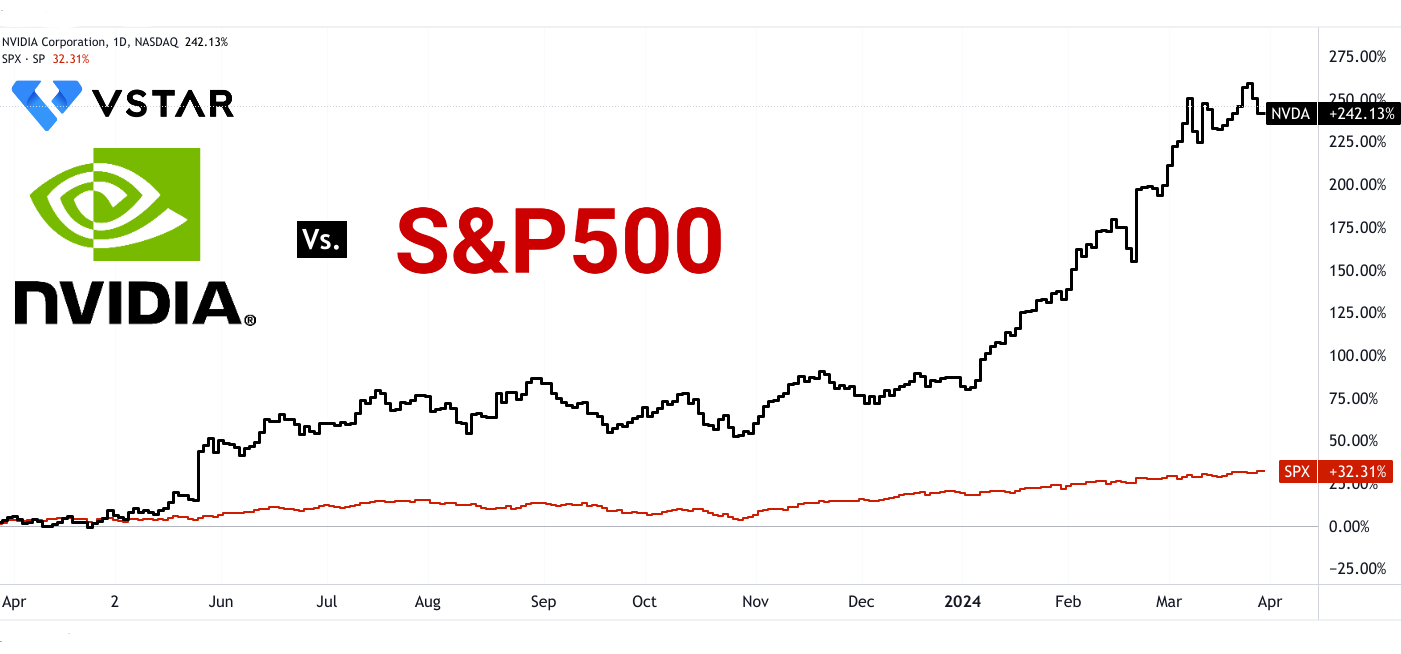
Source: tradingview.com
Nvidia Emerging Fundamental Moat
Advanced Computing Power:
Nvidia's Blackwell platform represents a significant leap in computing power, particularly tailored for AI applications.
Performance Improvements:
The Blackwell architecture delivers substantial performance improvements over its predecessor, the Hopper architecture. Specifically, it mentions a 2.5x performance increase for training in FP8 and a 5x increase for inference with FP4 per chip. These trends highlight the rapid advancement in computational capabilities achieved by Nvidia's Blackwell architecture. By quantifying the performance gains, investors and industry analysts can gauge the extent to which Nvidia is pushing the boundaries of accelerated computing.
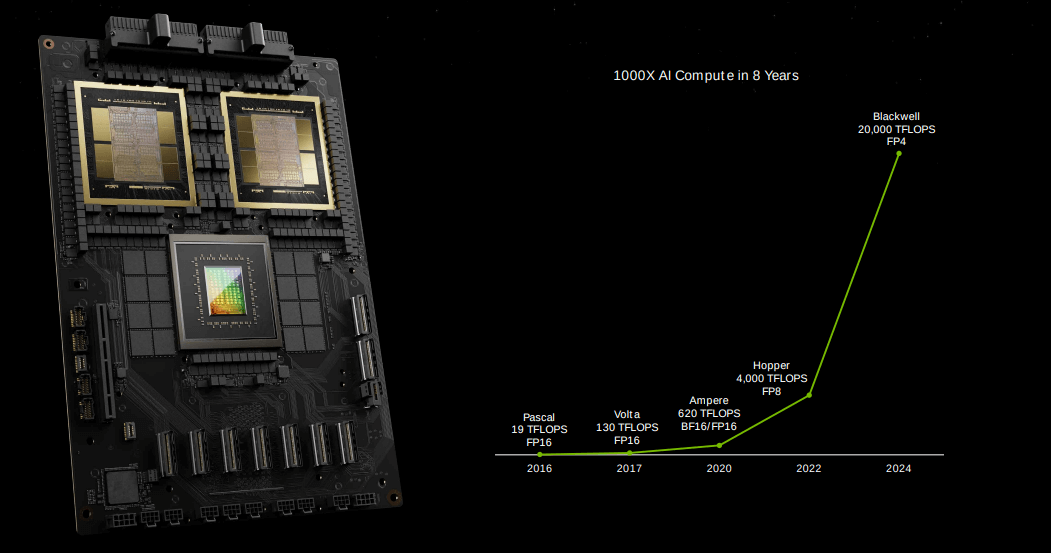
Source: Nvidia Blackwell Architecture GTC 2024
NVLink Interconnect Speed:
The fifth-generation NVLink interconnect offers twice the speed compared to the previous architecture, allowing for seamless high-speed communication among up to 576 GPUs. A throughput of 1.8 terabytes per second per GPU. This emphasizes Nvidia's focus on enhancing interconnect technologies, crucial for scaling AI workloads across distributed computing environments. The doubling of speed signifies a significant leap forward in data transfer rates, enabling more efficient parallel processing and collaboration among GPUs.
Superchip Performance:
The Nvidia GB200 Grace Blackwell Superchip, featuring two Blackwell Nvidia B200 Tensor Core GPUs connected to the Nvidia Grace CPU via a 900GB/s NVLink chip-to-chip interconnect, signifies a remarkable advancement in computational density and efficiency.
This showcases the intricate architecture of Nvidia's superchip, highlighting the high-speed interconnectivity between GPU and CPU components. This architecture facilitates efficient data exchange and parallel processing, essential for handling complex AI workloads.
Rack-Scale System Performance:
The Nvidia GB200 NVL72 system, which combines 36 Grace Blackwell Superchips to achieve remarkable AI training and inference performance. It specifies 720 petaflops of AI training performance and 1.4 exaflops of AI inference performance in a single rack. These metrics underscore the scalability and performance capabilities of Nvidia's rack-scale systems. Achieving exascale AI performance within a single rack demonstrates Nvidia's leadership in delivering high-performance computing solutions tailored for AI workloads.
Exaflop AI System:
The DGX SuperPOD powered by Nvidia GB200 Grace Blackwell Superchips delivers 11.5 exaflops of AI supercomputing at FP4 precision. This metric represents a significant milestone in achieving exascale computing for AI applications. This highlights Nvidia's ability to push the boundaries of AI supercomputing, enabling organizations to tackle complex AI challenges at unprecedented scales. By providing exascale computing capabilities, Nvidia empowers researchers and enterprises to accelerate AI innovation and discovery.
Industry Endorsements and Adoption:
Nvidia's Blackwell platform has garnered widespread endorsement and adoption across various industries, indicating strong confidence in its capabilities.

Source: investor.Nvidia.com
Endorsements:
The endorsements from industry leaders such as Alphabet, Amazon, Microsoft, Meta, and others. The presence of endorsements from major players in the tech industry underscores the significant impact and credibility of Nvidia's Blackwell platform. The sheer weight of these endorsements speaks volumes about the industry's confidence in Nvidia's technology. Investors and analysts can interpret these endorsements as indicators of the platform's potential to drive growth and innovation across various sectors.
Cloud Service Provider Adoption:
Major cloud service providers like Amazon Web Services, Google Cloud, Microsoft Azure, and Oracle Cloud Infrastructure were among the first to offer Blackwell-powered instances. The involvement of leading cloud providers signifies substantial adoption and integration of Nvidia's technology within cloud computing infrastructures.
Investors and analysts can infer the significance of cloud provider adoption by considering the market share and influence of these providers. The adoption of Blackwell-powered instances by major cloud platforms indicates strong market demand and positions Nvidia as a key player in the cloud AI space.
Global Partner Network:
Nvidia has established partnerships with a vast network of companies for Blackwell-based products and services, including cloud service providers, server manufacturers, software developers, and more. The breadth and diversity of partnerships suggest extensive collaboration and ecosystem integration.
Investors and analysts can assess the strength of Nvidia's partner network by considering the reputations and market presence of partner companies. A robust partner ecosystem enhances Nvidia's market reach and enables broader access to its technology, driving adoption and revenue growth.
Revolutionizing Software Development with Generative AI:
Nvidia's Blackwell platform is poised to revolutionize software development by leveraging generative AI technologies. This fundamental development may provide a solid topline growth edge for Nvidia. According to S&P Market Intelligence, the whole Gen AI market may experience 103% revenue growth in 2024.
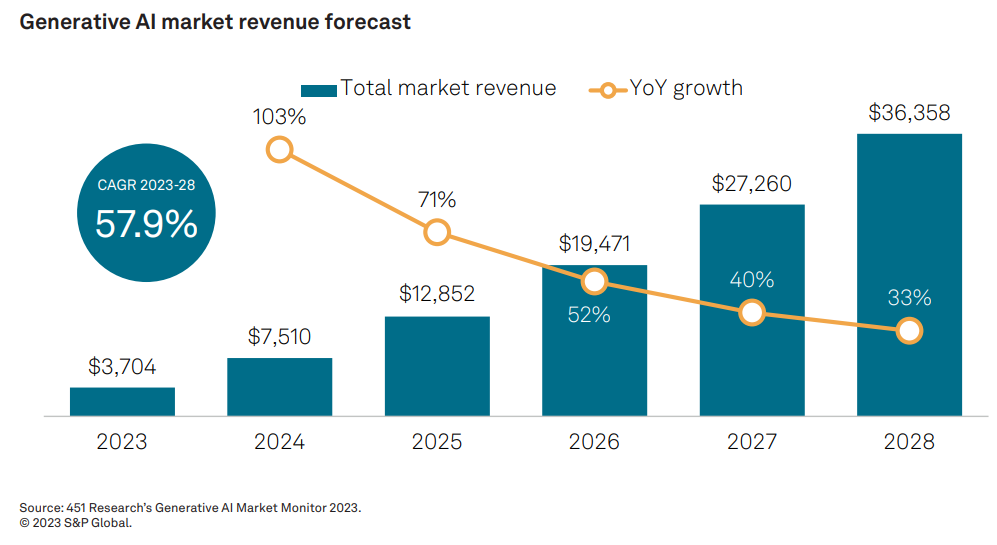
Source: S&P Market Intelligence
Transition to Generative AI:
The fundamental shift in software development towards generative AI. It highlights Nvidia's vision of assembling AI models to create software, rather than traditional coding approaches.
This shift represents a significant departure from conventional software development practices, with implications for efficiency, scalability, and innovation. The magnitude of this transformation and its potential to reshape the software industry.
Nvidia NIM Microservices:
Nvidia introduces NIM microservices, representing a new paradigm in software delivery. It emphasizes the scalability and versatility of NIM microservices, connecting developers with millions of GPUs for deploying custom AI solutions. The concept of NIM microservices suggests a scalable architecture capable of supporting diverse AI workloads. This scalability is critical for accommodating the growing demand for AI-driven applications across industries.

Source: investor.Nvidia.com
Industry Applications:
The collaboration with industry leaders like Cohesity, NetApp, SAP, ServiceNow, and Snowflake to build copilots and virtual assistants using Nvidia's technology. The involvement of prominent companies underscores the real-world applicability and value of Nvidia's generative AI solutions.
Investors and analysts can infer the significance of these collaborations by considering the market presence and reputation of the partner companies. The adoption of Nvidia's technology by industry leaders validates its effectiveness and positions Nvidia as a key enabler of AI-driven innovation across sectors.
Omniverse: Bringing AI to the Physical World
Nvidia's Omniverse platform may bridge the gap between AI and the physical world, enabling advanced simulation and automation.
AI Learning in the Physical World:
The Omniverse as a simulation engine for AI to learn about the physical world. The concept underscores Nvidia's focus on extending AI capabilities beyond digital environments.
This expansion into the physical world has significant implications for industries such as robotics, manufacturing, and autonomous systems. While quantitative metrics may not be explicitly outlined, the potential for AI-driven advancements in real-world applications.
Omniverse Cloud APIs:
Nvidia announces Omniverse Cloud APIs to extend the platform's reach into existing design and automation software applications. The integration of core Omniverse technologies, enabling seamless adoption within existing workflows.
The availability of Cloud APIs suggests Nvidia's focus on accessibility and interoperability, fostering broader adoption of Omniverse across industries. The expansion of Omniverse through Cloud APIs indicates potential for increased usage and integration within diverse application ecosystems.
Industry Adoption:
The partnerships with major industrial software makers like Ansys, Cadence, and Dassault Systèmes for integrating Omniverse Cloud APIs into their software. The involvement of leading companies underscores the platform's relevance and applicability across diverse industries.
Investors and analysts can interpret these partnerships as indicators of Omniverse's market acceptance and potential for driving innovation in industrial workflows. While quantitative metrics may not be extensively outlined, the breadth and depth of industry partnerships suggest significant market traction and potential for growth.
Nvidia Stock Forecast Technical Take
Fundamentally, projecting the price over the long-term average of non-GAAP (forward) PE of 46.17 with consensus EPS estimates for January 2025 of $24.81 provides a target of $1,145. Similarly, the theoretical target price for January 2026 is $1,390. Interestingly, these conservative projections signify a massive upside in the stock. The stock price of Nvidia is fundamentally impacted by EPS YoY growth, or bottomline expansion. Which reflects a 91.45% YoY boost in EPS for fiscal 2025 based on the Street estimates.
In short, the above-mentioned recent developments may provide solid support for the bottomline ascension over the upcoming quarters.
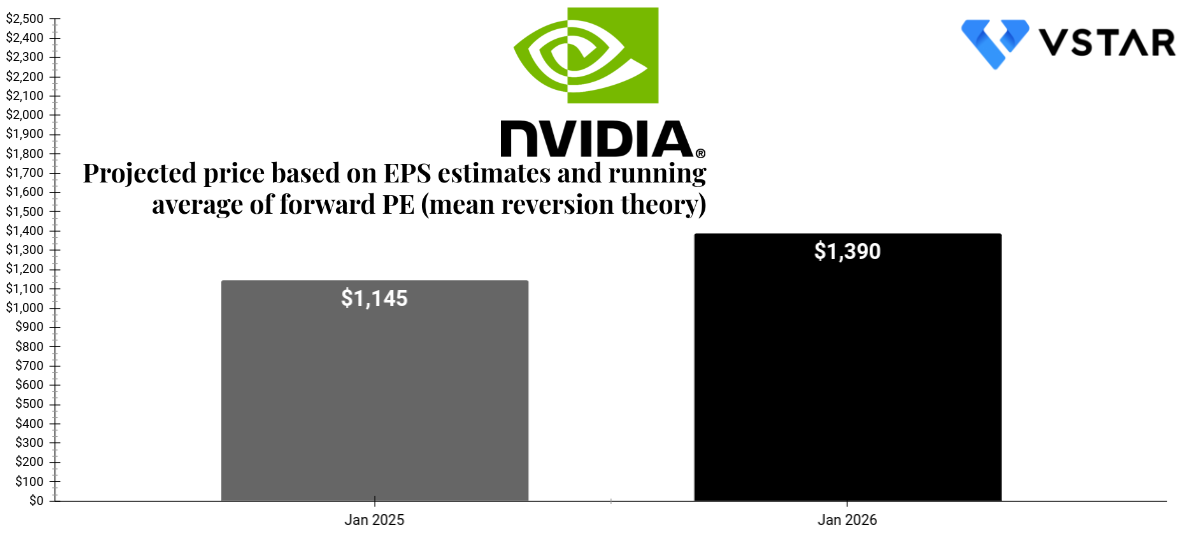
Source: Analyst's compilation
Technically, the Nvidia stock price may hit $1,165 by the end of April 2024, in an optimistic scenario. On average, the price may reach the same level by the end of May 2024. That is, by the end of Q2 fiscal 2025. In the pessimistic scenario, the price may reach $1,165 by mid-October 2024. The optimistic scenario is based on higher high momentum in the current NVDA stock price. Similarly, average cases are based on momentum at higher lows. Finally, the pessimistic scenario is based on mid-term price momentum.
These projections are based on Fibonacci retracement/extension levels projected over recent price swings.
Looking at the correlation between the price-to-earnings (GAAP) ratio and stock price. NVDA stock is fairly valued at the current price level. The current PE of 76 (black stepline) is near the long-term average (5Y) of the PE, which is 78 (Green SMA). Any correction in the stock price may provide an opportunity to establish long positions on the stock for an investment horizon of less than 12 months. The precise support zone is between $807 and $785. This zone is the upper bond of the current horizontal price channel.
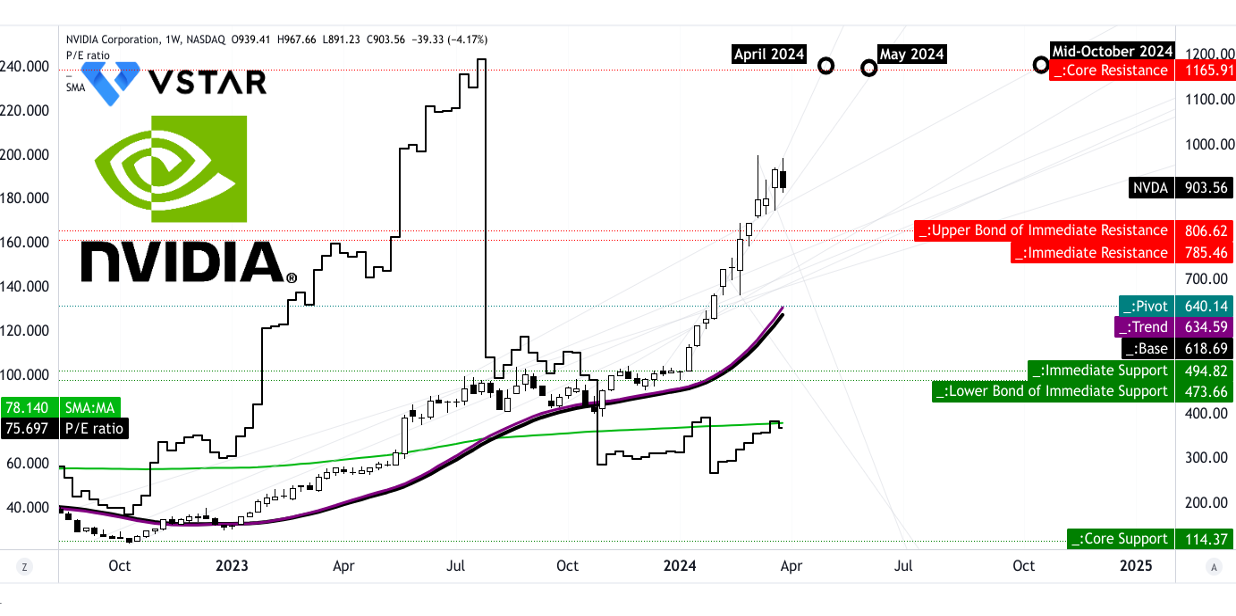
Source: tradingview.com
Downsides
Dependency on Specialized Hardware:
The Blackwell GPU architecture features six transformative technologies, boasting 208 billion transistors and utilizing a custom-built 4NP TSMC process. The specialized hardware, while offering superior performance, suggests potential scalability challenges due to the significant investment required. The precise cost of manufacturing these GPUs and associated hardware components is not explicitly announced.
However, the scale of production and the cost per unit are crucial factors influencing scalability. If the cost remains high and production scalability is limited, it could hinder widespread adoption of the Blackwell platform.
Complexity and Integration Issues:
The Blackwell platform introduces a complex architecture, including fifth-generation NVLink interconnects, RAS engine, secure AI capabilities, and a decompression engine, among others. While these features enhance performance and security, they also increase system complexity, potentially leading to integration challenges. However, the presence of multiple advanced technologies suggests a higher degree of complexity compared to previous architectures. Overall, complexity could translate to higher deployment and maintenance costs, deterring organizations from scaling their adoption of Blackwell-based solutions.
In conclusion, the technical analysis suggests a bullish trend for Nvidia's stock price, with a potential target of $1165 in the short term. Despite short-term fluctuations, the long-term trajectory remains upward, supported by strong fundamentals and industry endorsements. For establishing long positions, especially during price corrections, the support zone of $807 to $785 can be considered. However, cautious monitoring is advised due to Nvidia's dependency on specialized hardware and integration complexities, which may affect scalability of Blackwell-based solutions.









